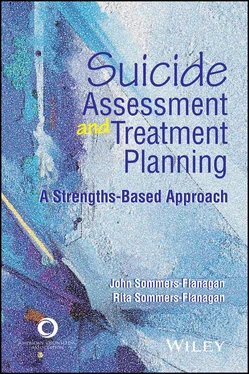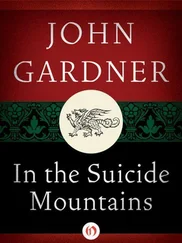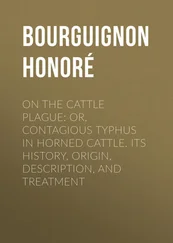John Sommers-Flanagan - Suicide Assessment and Treatment Planning
Здесь есть возможность читать онлайн «John Sommers-Flanagan - Suicide Assessment and Treatment Planning» — ознакомительный отрывок электронной книги совершенно бесплатно, а после прочтения отрывка купить полную версию. В некоторых случаях можно слушать аудио, скачать через торрент в формате fb2 и присутствует краткое содержание. Жанр: unrecognised, на английском языке. Описание произведения, (предисловие) а так же отзывы посетителей доступны на портале библиотеки ЛибКат.
- Название:Suicide Assessment and Treatment Planning
- Автор:
- Жанр:
- Год:неизвестен
- ISBN:нет данных
- Рейтинг книги:4 / 5. Голосов: 1
-
Избранное:Добавить в избранное
- Отзывы:
-
Ваша оценка:
- 80
- 1
- 2
- 3
- 4
- 5
Suicide Assessment and Treatment Planning: краткое содержание, описание и аннотация
Предлагаем к чтению аннотацию, описание, краткое содержание или предисловие (зависит от того, что написал сам автор книги «Suicide Assessment and Treatment Planning»). Если вы не нашли необходимую информацию о книге — напишите в комментариях, мы постараемся отыскать её.
Suicide Assessment and Treatment Planning — читать онлайн ознакомительный отрывок
Ниже представлен текст книги, разбитый по страницам. Система сохранения места последней прочитанной страницы, позволяет с удобством читать онлайн бесплатно книгу «Suicide Assessment and Treatment Planning», без необходимости каждый раз заново искать на чём Вы остановились. Поставьте закладку, и сможете в любой момент перейти на страницу, на которой закончили чтение.
Интервал:
Закладка:
7 We value the positive emphasis of safety planning and coping skills development over the negative components of no-suicide contracts and efforts to eliminate suicidal thoughts.
The Book’s Organizing Themes
This book includes 10 chapters organized to build on one another in ways that are consistent with our understanding of the research literature in suicide theory, research, and practice. We begin our discussion of the seven dimensions with the emotional dimension, because, as Edwin Shneidman (1993) wrote, psychological or emotional distress is the primary driving force at the heart of suicide. In our model, all risk factors and life dimensions contribute in some way or another to deep and excruciating emotional distress, and deep and excruciating emotional distress pushes people toward suicide.
Language Use
This book is written for counseling professionals and other professionals who work directly or indirectly with people who are suicidal. As a consequence, although we usually refer to counselors and counseling , we also use the words clinician or practitioner to recognize members of other disciplines who provide counseling or mental health services. When referring to the people who receive counseling or treatment, we usually use the word client , but we also use student or patient as a method of incorporating school counselors and health professionals who work in medical settings.
In all cases, we strive to use person-first language. Instead of reading the phrase suicidal clients , you will read the slightly more cumbersome clients who are suicidal . Using person-first language is essential to separating the problem from the person and is consistent with the constructionist or social constructionist theory that undergirds the strengths-based approach.
We avoid using language and phrases that have a history of offending people. For example, unless quoting others, we do not use the phrase commit suicide . We try to use positive language to refer to people who are suicidal. We occasionally use the language of mental disorders, but because we do not want to tightly construct suicide or mental disorders as internalized pathological states, more often we avoid negative labeling. These ways in which we are using language are foundational to our strengths-based approach.
Information in this book is broadly research based. When discussing evidentiary support, we use the following terminology:
Incorporating Positive Psychology
Positive psychology is broadly defined as the scientific study of well-being and human experiences that contribute to a well-lived life. To balance our focus on suicide and to practice a strengths-based orientation in this book, in each chapter we include a pullout box on how to use a specific positive psychology intervention to elevate mood. We call these sidebars Wellness Practices . Each one is founded on research or common sense and can be applied to you—as a practitioner—or used therapeutically with your students, clients, or patients. We encourage you to try these wellness practices with a hopeful spirit of experimentation.
Case Material
Case material in this book is used to illustrate the many ways in which suicidality manifests and the many ways in which providers can work with clients and students. All cases are anonymous; they are often composites of multiple cases. Age, sex, gender, and other identifying factors were sometimes changed. Several cases are adapted from video simulations (for a three-part, 7.5 hour video training, see: https://www.psychotherapy.net/video/suicidal-clients-series.
About the Authors
John Sommers-Flanagan, PhD, is a professor of counseling at the University of Montana. He is the author or coauthor of more than 100 professional publications, including the books Tough Kids, Cool Counseling (2007, American Counseling Association), Clinical Interviewing (6th ed., 2017, Wiley), and Counseling and Psychotherapy Theories in Context and Practice (3rd ed., 2018, Wiley). When not immersed in writing, speaking, teaching, and researching, John keeps busy watering the zucchini, picking beans, and starring in videos along with his grandchildren. He also excels at making pancakes, waffles, and quiche. He was drawn to writing this book because of his earnest belief that effective suicide assessment and intervention simply must become more positive, skilled, and compassionate. You can find what he is up to on his blog, https://johnsommersflanagan.com/.
Rita Sommers-Flanagan, PhD, is an author, counselor, passive solar advocate, and professor emerita of counseling at the University of Montana, with many published books and articles. She enjoys collecting rocks and driftwood, jogging, blogging, and contemplating the meaning of life. Her experiences with and views about suicide have been shaped and changed by clients, colleagues, students, and friends who have had to cope with the phenomenon of suicide clinically and/or personally. She looks forward to writing further in this area, including addressing end-of-life policies and practices as they intersect with the materials in this book. In the meantime, you can follow her on her blogs: https://drbossypants.wordpress.com/author/ritasf13/and https://godcomesby.com/.
As coauthors, the Sommers-Flanagans have stylistic differences that are distinct but usually complementary. John dives way too far down various rabbit holes, skims and reads too many journal articles and book chapters, jots notes on several hundred different small pieces of paper, and then begins a word processing version of loose associations about arcane facts. (Did you know that suicide rates among males older than 85 in the United States are 13.17 times higher than suicide rates among females older than 85 in the United States? Should we include results from that one cool study showing that trait impulsiveness is not associated with increased suicide attempts but that negative state-triggered impulsiveness is linked to suicide attempts?) At some point, Rita nudges John out of his loose associations and research reveries, takes her commonsense garden clippers to John’s meandering prose, pulls a few of his worst puns, and voilà! After mostly agreeing with each other’s brilliance, they send the resulting draft out to a plethora of volunteer readers, collect feedback, marvel at the diversity in perspective, integrate the input, get organizing and copyediting assistance through the publisher, and end up with pretty much what you are about to read.
Acknowledgments
This book was made possible by the amazing work of many researchers, practitioners, suicide survivors, students, clients, and suicidologists who came before us and illuminated the way. We are indebted to all of them. We are also grateful to the American Counseling Association’s editorial team—Carolyn Baker, Nancy Driver, Bonny Gaston, and others—who have helped make our words clearer and our points sharper. A big thanks to Pete MacFadyen, Katie DiBerardinis, and Robin Hill of the Big Sky Youth Empowerment Program for their support of our work and their commitment to suicide prevention in Montana. Thanks also to Victor Yalom of Psychotherapy.net and Kelley Donisthorpe of the University of Montana.
We offer special thanks to Erin Binkley of Wake Forest University and Victor Chang of Southern Oregon University for their thorough reviews and detailed feedback. Thanks also to the many professionals who volunteered to read a chapter or two or the whole manuscript. Your insightful comments and feedback have resulted in a better book:
Alexis Cancemi – Alexis Mental Health, North Miami Beach, Florida
Читать дальшеИнтервал:
Закладка:
Похожие книги на «Suicide Assessment and Treatment Planning»
Представляем Вашему вниманию похожие книги на «Suicide Assessment and Treatment Planning» списком для выбора. Мы отобрали схожую по названию и смыслу литературу в надежде предоставить читателям больше вариантов отыскать новые, интересные, ещё непрочитанные произведения.
Обсуждение, отзывы о книге «Suicide Assessment and Treatment Planning» и просто собственные мнения читателей. Оставьте ваши комментарии, напишите, что Вы думаете о произведении, его смысле или главных героях. Укажите что конкретно понравилось, а что нет, и почему Вы так считаете.











